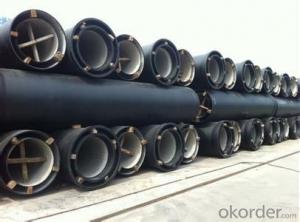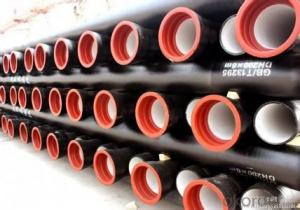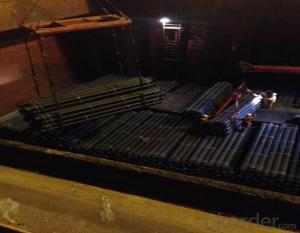DUCTILE IRON PIPE K9 DN80
- Loading Port:
- China Main Port
- Payment Terms:
- TT OR LC
- Min Order Qty:
- -
- Supply Capability:
- -
OKorder Service Pledge
OKorder Financial Service
You Might Also Like
Ductile Iron Cast Pipe is without any defects compare with tradition casting tech, which has many advantages particularly as follow:
(1) High density. In the "vertical upward casting" process, the melt iron of centre liquid column in center crystallizer is continuously feeding for volume shrinkage caused by condensation tube at outer circumference , which lead to be free of shrinkage porosity.
(2) High purity. When melt iron pouring, the mixed impurities such as gas, dross, sand grain which are lighter than melt iron could be eliminated at furnace mouth, its impossible to enter into the crystallizer through the channel, so the melt iron into the crystallizer is very pure.
(3) Strength with toughness. The cooling speed provided by continuous crystallizer is 30 times than sand casting and 5 times than centrifugal casting, and doesn't produce white iron, the eutectic cell volume of continuous cast iron is one eighth to one tenth compare with traditional cast iron. The density of graphite nodule in ductile iron can reach 300-700 pcs/mm2. Therefore, all reason above improve the strength and toughness of continuous cast iron.
(4) Free machining. The high speed cooling make the hardening phase (such as boride, steadite) not appear like reticular, massive or thick, but diffuse like fish bone and pane in shape, moreover, there are tiny graphite flakes inlaid hardening phase. It's free machining in BrinellHardness the range of 250-300HB. However, the Brinell Hardness of 250 is top limit to common metal materials.
(5) Uniform composition of tube wall. The convection mixing of liquid column caused by marching type drawing in crystallizer make the composition of tube wall well-distributed, and concentration gradient very little.
(6) High productivity. To the wall thickness of tube under 10mm, the speed of continuous casting is 1 meter/min, to the wall thickness of tube under 20mm, the speed of continuous casting is 0.5 meter/min, which is high efficiency that centrifugal or other casting tech couldn't reach.
- Q:Are ductile iron pipes suitable for tunneling projects?
- Ductile iron pipes are well-suited for tunneling projects due to their strength, durability, and flexibility. With their ability to endure high pressure and heavy loads, they are an excellent choice for underground tunnels. These pipes are also highly resistant to corrosion, which is vital in moist and chemical-laden underground environments. Furthermore, their installation and maintenance are relatively simple, making them a cost-effective option for tunneling endeavors. In summary, ductile iron pipes possess the essential characteristics needed for tunneling projects, making them a fitting selection for these applications.
- Q:Which is better, ductile iron pipe and spray plastic pipe?
- Spray pipe is: plastic composite pipe, steel pipe is a new composite material as matrix, through a special process in high temperature curing by walls melt spraying or adsorption of food grade epoxy powder coating or PE as raw material. It has excellent corrosion resistance and relatively small frictional resistance.
- Q:How many degrees can the ductile iron pipe be each?
- Minimum tensile strength: 420/Mpa, minimum yield strength: 300/Mpa, minimum elongation 7%.
- Q:What is the expected pressure rating of ductile iron pipes?
- The expected pressure rating of ductile iron pipes can vary depending on various factors such as pipe diameter, wall thickness, and type of joint used for installation. However, generally speaking, ductile iron pipes are known for their high strength and durability, allowing them to withstand high pressure levels. In most cases, ductile iron pipes are designed and manufactured to meet or exceed the requirements of industry standards such as the American Water Works Association (AWWA) C151 or C115/A21.15. These standards specify the minimum pressure rating for ductile iron pipes, which typically range from 150 to 350 psi (pounds per square inch) for water transmission applications. It is important to note that the pressure rating also depends on the class of the pipe, which refers to the thickness of the pipe's wall. Typically, ductile iron pipes are available in different classes such as Class 50, Class 51, Class 52, etc. Each class has its own pressure rating, with higher classes offering greater strength and resistance to pressure. It is recommended to consult the manufacturer's specifications and guidelines for the specific ductile iron pipes being used to determine the exact pressure rating. It is also essential to consider other factors such as pipe support, installation methods, and operating conditions to ensure the safe and efficient operation of the ductile iron pipe system.
- Q:How are ductile iron pipes protected against stray electrical currents?
- To safeguard water and sewer systems, ductile iron pipes are shielded from stray electrical currents through a technique called cathodic protection. This process entails the application of a low-voltage direct current (DC) to the pipes, generating a defensive electrical field around them. To achieve cathodic protection, sacrificial anodes or impressed current systems are installed near the ductile iron pipes. Sacrificial anodes, composed of a more electrically active metal like zinc or magnesium, are connected to the pipes and act as the electrical current source. Over time, these anodes corrode, sacrificing themselves to shield the pipes from corrosion caused by stray electrical currents. However, impressed current systems utilize an external power source to supply the protective electrical current. Rectifiers are employed to convert alternating current (AC) to direct current (DC), which is then administered to the pipes through anodes. This approach provides greater control over the amount of current applied, ensuring optimal protection. In both scenarios, the electrical current flowing through the sacrificial anodes or impressed current systems establishes a protective barrier around the ductile iron pipes. This barrier impedes the flow of stray electrical currents through the pipes, thus diminishing the risk of corrosion and prolonging the infrastructure's lifespan. Regular monitoring and maintenance of the cathodic protection system are crucial to uphold its efficacy. This involves inspecting the anodes, assessing the levels of electrical current, and making any necessary adjustments or replacements to maintain the desired level of protection. To summarize, cathodic protection is a dependable and widely utilized method for safeguarding ductile iron pipes against stray electrical currents. By preserving the integrity and longevity of water and sewer systems, it plays a vital role in ensuring their functionality.
- Q:Can ductile iron pipes be used for agricultural applications?
- Yes, ductile iron pipes can be used for agricultural applications. Ductile iron is a strong and durable material that is resistant to corrosion, making it suitable for various agricultural purposes. These pipes can be used for irrigation systems, drainage systems, water supply systems, and other agricultural infrastructure projects. Ductile iron pipes have a high tensile strength and can withstand the external pressures and stress that may occur in agricultural environments. Additionally, they have a long lifespan, reducing the need for frequent replacements, and are capable of handling high water flow rates. Therefore, ductile iron pipes are a reliable choice for agricultural applications.
- Q:Can ductile iron pipes be installed outdoors?
- Ductile iron pipes can be installed outdoors.
- Q:Can ductile iron pipes be used in culvert or storm sewer applications?
- Yes, ductile iron pipes can definitely be used in culvert or storm sewer applications. Ductile iron pipes are known for their strength, durability, and flexibility, making them ideal for such applications. They have the ability to withstand heavy loads, resist corrosion, and handle high flow rates, making them a reliable choice for culverts and storm sewers. Ductile iron pipes also have a long service life and require minimal maintenance, further adding to their suitability for these applications. Additionally, ductile iron pipes can be easily installed and are available in various sizes and configurations to meet the specific requirements of culvert or storm sewer projects. Overall, ductile iron pipes are a proven and widely used option for culvert or storm sewer applications, providing efficient and long-lasting performance.
- Q:Are ductile iron pipes suitable for use in chemical processing plants?
- Yes, ductile iron pipes are suitable for use in chemical processing plants. Ductile iron is known for its high strength and durability, making it resistant to corrosion and capable of withstanding high pressure and extreme temperatures. Additionally, its smooth internal surface reduces friction and allows for efficient flow of chemicals.
- Q:What are the different types of linings available for ductile iron pipe?
- Ductile iron pipes offer various linings with distinct advantages and applications. 1. Cement mortar lining: The most commonly used lining for ductile iron pipes is cement mortar. It involves applying a layer of cement mortar to the pipe's interior surface. This lining excels in resisting corrosion and chemical attacks, making it suitable for potable water distribution, wastewater conveyance, and industrial pipelines. Additionally, it improves flow efficiency by reducing friction and turbulence within the pipe. 2. Polyethylene lining: Ductile iron pipes often utilize polyethylene linings when corrosion resistance is a primary concern. This lining consists of a layer of high-density polyethylene (HDPE), either extruded or sprayed onto the inner surface of the pipe. Polyethylene lining provides exceptional resistance to corrosion, abrasion, and chemical attacks, making it ideal for transporting aggressive fluids such as saltwater, chemicals, or industrial waste. 3. Polyurethane lining: For applications requiring protection against abrasive wear, polyurethane linings are commonly employed in ductile iron pipes. This lining is created by spraying or pouring a layer of polyurethane onto the inner surface of the pipe. Polyurethane lining offers excellent resistance to abrasion, impact, and chemical attacks. It is suitable for conveying abrasive slurries, mining applications, and other high-wear environments. 4. Epoxy lining: To safeguard against corrosion and chemical attacks, epoxy linings are applied to ductile iron pipes. This lining is typically formed by applying a layer of epoxy resin to the pipe's inner surface using centrifugal casting or electrostatic spraying. Epoxy lining demonstrates outstanding adhesion and corrosion resistance, making it suitable for various applications like potable water distribution, wastewater treatment, and industrial pipelines. 5. Zinc lining: Ductile iron pipes employ zinc linings to provide cathodic protection against corrosion. This lining involves applying a layer of zinc to the pipe's inner surface through hot-dip galvanizing or electroplating. Zinc lining acts as a sacrificial anode, corroding preferentially to the iron pipe and shielding it from corrosion. It is commonly used in highly corrosive environments like seawater or acidic soils. Ultimately, the selection of a lining for ductile iron pipes relies on the specific requirements of the application, including the transported fluid, desired corrosion resistance, and potential for abrasive wear. Seeking guidance from industry experts and considering factors like cost, longevity, and maintenance requirements aids in determining the most suitable lining option for a particular project.
1. Manufacturer Overview |
|
|---|---|
| Location | |
| Year Established | |
| Annual Output Value | |
| Main Markets | |
| Company Certifications | |
2. Manufacturer Certificates |
|
|---|---|
| a) Certification Name | |
| Range | |
| Reference | |
| Validity Period | |
3. Manufacturer Capability |
|
|---|---|
| a)Trade Capacity | |
| Nearest Port | |
| Export Percentage | |
| No.of Employees in Trade Department | |
| Language Spoken: | |
| b)Factory Information | |
| Factory Size: | |
| No. of Production Lines | |
| Contract Manufacturing | |
| Product Price Range | |
Send your message to us
DUCTILE IRON PIPE K9 DN80
- Loading Port:
- China Main Port
- Payment Terms:
- TT OR LC
- Min Order Qty:
- -
- Supply Capability:
- -
OKorder Service Pledge
OKorder Financial Service
Similar products
New products
Hot products
Related keywords




























